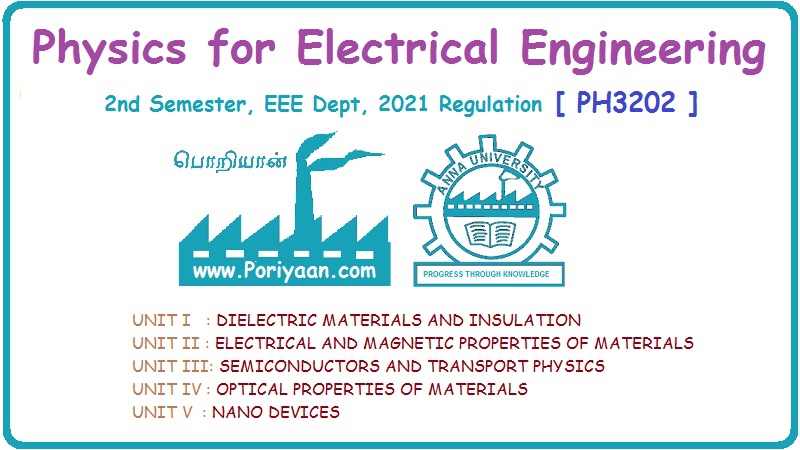Physics for Electrical Engineering: Unit II: a. Electrical Properties of Materials
Anna university solved problems
Electrical Properties of Materials | Physics for Electrical Engineering
Physics for Electrical Engineering: Unit II: Electrical and Magnetic Properties of Materials : Anna university solved problems
ANNA UNIVERSITY
SOLVED PROBLEMS
Problem 2.4
Calculate electrical conductivity
in copper if the mean free path of electrons is 4 × 10-8 m, electron
density is 8.4 × 10-8 m, and average thermal velocity of electron is
1.6 × 106 ms-1. (A.U Dec 2012)
Given data
Mean
free path of electron λ = 4 × 10-8 m
Electron
density n = 8.4 × 1028 m- 3
Average
thermal velocity of the electrons v = 1.6 × 106 ms- 1
Charge
of an electron e = 1.6 × 10-19 kg
Mass
of an electron m = 9.11 × 10-31 kg
Solution
We
know that σ =ne2λ / mv ( τ = λ/v)
Substituting
the given values, we have
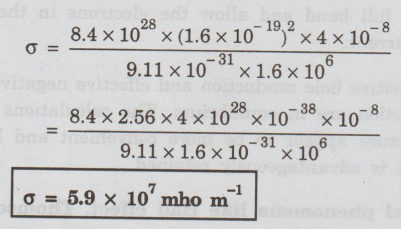
σ = 5.9 × 107 mho m-1
Problem 2.5
Calculate electrical and thermal
conductivities for a metal with a relaxation time 10-14 second at
300 K. Also, calculate Lorentz number using the above result (density of
electrons = 6 × 1028 m-3).
(A.U. June 2013)
Given data
Relaxation
time τ = 10-14 S
Temperature
T= 300 K
Electron
concentration n = 6 × 1028 m- 3
Mass
of an electron m = 9.1 × 10-31kg
Charge
of an electron e = 1.6 × 10-19 C.
Boltzmann's
constant k = 1.38 × 10-23 Jk-1
Solution
We
know that σ = ne2 τ / m
Substituting
the given values, we have
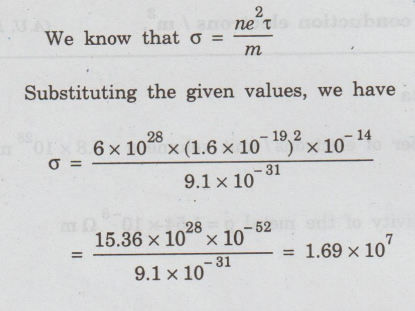
Electrical
conductivity σ = 1.69 × 107Ω -1m-1
Thermal
conductivity K = π2/3 nk2τT/m
(By quantum free electron theory)
Substituting the given values, we have
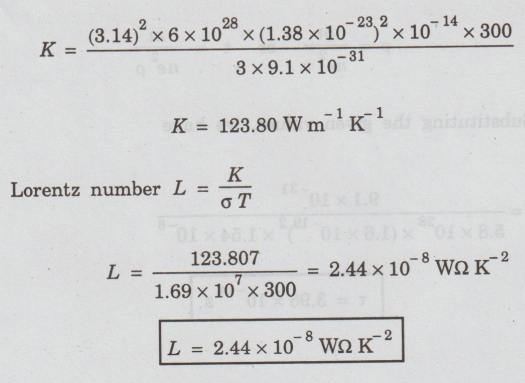
L
=2.44 × 10-8 W Ω K-2
Problem 2.6
Find the relaxation time of
conduction electrons in a metal of resistivity 1.54 × 10-8 ohm-m if
the metal has 5.8 × 1028 conduction electrons / m3. (A.U. May 2008)
Given data
Number
of electrons / unit volume n = 5.8 × 1028 m-3
Resistivity
of the metal ρ = 1.54 × 10-8 Ωm
Solution
We
know that the electrical conductivity of a metal
σ
= n e2τ /m [ρ = 1/σ]
ρ
= m / ne2τ or τ = m / ne2ρ
Substituting
the given values, we have
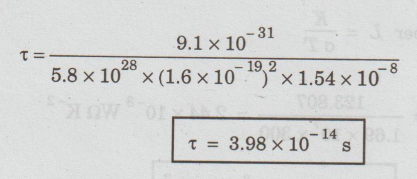
τ
= 3.98 × 10-14 s
Problem 2.7
A uniform silver wire has a
resistivity of 1.34 ×
10-8 Ωm at room temperature for an electric field of 1 volt/cm.
Calculate (i) the drift velocity (ii) the mobility and (iii) the relaxation
time of electrons assuming that there are 5.8 × 1028 conduction electrons of the material. (A.U. May
2009)
Given data
Resistivity
of the wire ρ = 1.34 × 10-8 Ωm
Electrical
field E = 1V/cm = 1 V / 10-2 m = 1 × 102 Vm-1
Number
of electron per unit volume n = 5.8 x 1028m-3
Solution
Electrical
conductivity σ = ne2τ / m
Or
1/ρ = ne2 τ / m [σ = 1/ρ]
Τ
= m/ρne2
Substituting
the given values, we have

τ
= 4.57 × 10-14 s
Drift
velocity is given by vd = e E τ / m

vd
= 0.804 ms-1
Mobility
μ = vd / E =0.804/ 102 =
0.804 × 10-2 m2 V-1s-1
μ
= 8.04 × 10-3 m2 V-1 s-1
Problem 2.8
Calculate the drift velocity and
thermal velocity of conduction electrons in copper at a temperature of 300 K.
When a copper wire of length of 2 m and resistance 0.02Ω carries a current of
15 A.
Given mobility μ = 4.3 x 10-3m2V-1s-1
(A.U. Jan 2014)
Given data
Temperature
T = 300 K
Length
of the wire L = 2 m
Resistance
R = 0.02 Ω
Current
I= 15 A
Mobility
μ = 4.3 x 10-3m2V-1s-1
Solution
Voltage
drop V across the wire is
V
= IR = 15 × 0.02=0.3 V
Electric
field E across the wire is given by
E
= V / L = 0.3/2 = 0.15 Vm-1
Drift
velocity
vd
= μE = 4.3 × 10-3 × 0.15 = 0.645 × 10-3
vd
= 0.645 × 10-3 ms-1
We
know that 3/2 kT = ½ mv2
where
v is thermal velocity
v2
= 3kT / m
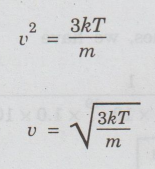
Substituting
the given values, we have

V
= 1.17 × 105ms-1
Problem 2.9
Find the drift velocity of the free
electrons in a copper wire whose cross sectional area is 1.0 mm2
when the wire carries a current of 1A. Assume that each copper atom contributes
one electron to the electron gas. Given n = 8.5 × 1028 m-3. (A.U. May 2016)
Given Data
Conduction
electron/m3, n = 8.5 × 1028 m-3
Charge
of electron e = 1.6 × 10-19 C
Area
of cross section A = 1.0 × 10-6 m2
Current
I = 1.0 A
Solution
The
drift velocity of the free electrons is given by
vd
= I / neA (J= ne vd and J=I/A)
Substituting
the given values, we have

vd
= 7.4 × 10-5 ms-1
Problem 2.10
A metallic wire has a resistivity
of 1.42 × 10-8 Ωm an electric field of 0.14 V/m. Find (i) average
drift velocity and (ii) mean collision time, assuming that there are 6 x 1028
electrons / m3. (A.U.
April 2015)
Given data
Electric
field E = 0.14 Vm-1
Resistivity
ρ = 1.42 × 1028 m-3
Number
of electrons per unit volume n = 6 × 1028 m-3
Charge
of the electron e = 1.6 × 10-19C
Mass
of an electron m = 9.1 x 10-31kg
Solution:
The
resistivity of a metal is given by,
ρ
= m / ne2 τ
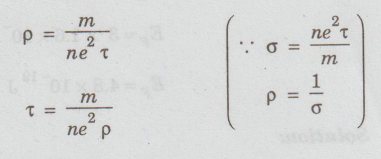
Substituting
the given values, we have
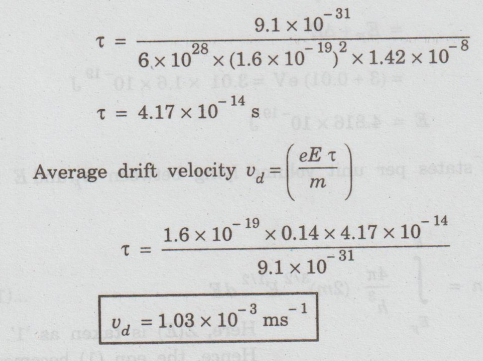
Vd
= 1.03 × 10-13ms-1
Density of energy states
Problem 2.11
Calculate the number of states
lying in an energy interval of 0.01 eV above the Fermi level for a crystal of
unit volume with Fermi energy EF= eV (A.U.
June 2010)
Given data
Mass
of electron m = 9.1 × 10-31kg
Energy interval ∆E= 0.01 eV
Planck's
constant h = 6.63 x 10-34 Js
Fermi
energy. EF = 3 eV [ 1eV = 1.6 × 10-19J]
EF
= 3 × 1.6 × 10-19 J
EF
= 4.8 × 10-19 J
Solution:
We
know that ∆E = E - EF
=
EF+ ∆E
=
(3+0.01) eV = 3.01 × 1.6 × 10-19 J
E
= 4.816 × 10-19J
Number
of states per unit volume lying between EF and E is given by
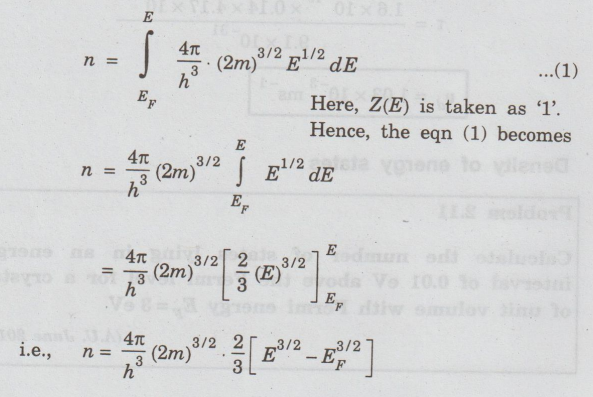
Substituting
the given values, we have
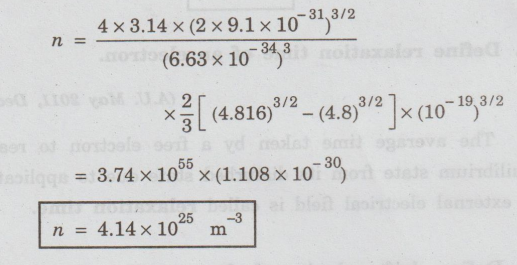
n
= 4.14 x 1025 m-3
Physics for Electrical Engineering: Unit II: a. Electrical Properties of Materials : Tag: : Electrical Properties of Materials | Physics for Electrical Engineering - Anna university solved problems
Related Topics
Related Subjects
Physics for Electrical Engineering
PH3202 2nd Semester 2021 Regulation | 2nd Semester EEE Dept 2021 Regulation
